We may not have the course you’re looking for. If you enquire or give us a call on 01344203999 and speak to our training experts, we may still be able to help with your training requirements.
Training Outcomes Within Your Budget!
We ensure quality, budget-alignment, and timely delivery by our expert instructors.
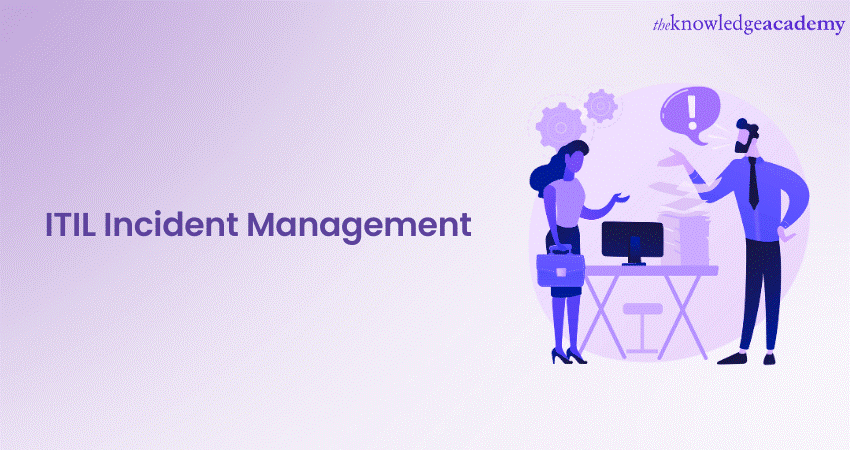
Modern organisations are required to manage IT incidents due to the rapid digital transformation. This is where ITIL Incident Management steps in as a concrete framework. Moreover, Incident Management is a crucial process that ensures the rapid restoration of normal service operations. Along with this, it minimises the impact of Incidents on business operations.
Thus, modern enterprises must learn about this framework and prevent their IT services from getting disrupted. Read this blog to know about ITIL Incident Management in detail, its processes and flow. It will also help to learn the key differences between Incident Management and Problem Management.
Table of Contents
1) What is ITIL Incident Management?
2) Difference between Incident Management and Problem Management
3) What are the causes of major incidents?
4) ITIL Incident Management process
5) Benefits of implementing ITIL Incident Management
6) Example of Incident Management
7) Best Practice for Implementing Incident Management
8) Incident Management tools
9) Roles in ITIL Incident Management
10) Conclusion
What is ITIL Incident Management?
An efficient method for handling and resolving issues in IT Service Management (ITSM) is ITIL Incident Management. This mainly addresses the interruptions or deteriorations that impede the regular operation of IT systems. With its roots in the Information Technology Infrastructure Library (ITIL), it restores normal service operation swiftly. The following points talk about the key aspects of ITIL Incident Management:
a) Incident identification and analysis: The process begins by identifying and recording incidents. These can range from a laptop crashing to network downtime. IT teams analyse the incidents to understand their impact and urgency.
b) Incident resolution: The emphasis switches to quickly resolving an event after it has been detected. To reduce downtime and interruptions, ITIL strongly emphasises effective incident resolution.
c) Communication and transparency: Incident management ensures transparent communication with stakeholders. Regular updates keep everyone informed about ongoing incidents and their resolution progress.
d) Preventing future incidents: Beyond immediate resolution, ITIL Incident Management aims to prevent similar incidents in the future. By analysing root causes, organizations can implement preventive measures.
Difference between Incident Management and Problem Management
The key differences between Incident Management and ITIL Problem Management are as follows:
|
Basis of difference |
Incident Management |
Problem Management |
|
Definition |
It is characterised by the fastest possible return of service to normal following an incident, with the least amount of disruption to company activities. |
It is the process of identifying, analysing, and resolving the root cause of one or more incidents, in order to prevent their recurrence. |
|
Focus |
The focus of this process is to be reactive to issues. |
This process focuses on being proactive against future problems using historical data. |
|
Goal |
The goal is to restore normal service and operations quickly and effectively. |
The goal is to establish a process to prevent problems or issues from happening in the first place. |
|
Scope |
The scope is limited to managing the Incident and its impact on business. |
There is a broader impact, as it addresses the underlying root causes behind Incidents. |
|
Trigger point |
The trigger point of an Incident Management process is when an incident actually occurs of the incident. |
The trigger point of a Problem Management Process is detecting patterns or trends identified in the past. |
|
Timeframe |
Since Incident Management primarily deals with the current issue, it has a limited lifespan. | The Problem Management is set in such a way that it has a longer-term advantage. Its purpose is to develop the comprehension of the causes of the uneven flow of events. |
|
Process |
Incident Management follows a pre-defined process to restore services as quickly as possible. |
Problem Management follows a defined process to identify, analyse, and resolve the underlying root cause(s) of incidents. |
|
Desired outcome |
The desired outcome of this process is that the incident is resolved, and service is restored. |
The desired outcome of this process is that the cause(s) of recurring incidents are identified and resolved to prevent them from happening again. |
Despite their similarities, Incident Management and Process Management are two different processes that differ in numerous ways. A combination of both can optimally benefit organisations and prevent the recurrence of incidents.
Enhance your skills in Incident Management with our ITIL® 4 Practitioner: Incident Management Training!
What are the causes of major incidents?
In ITIL, a major “incident” is an event that causes significant damage and disruption to an organisation's IT operations or services. Major incidents are typically identified, characterised and prioritised by their impact, urgency and complexity. They require immediate and coordinated responses from IT teams to minimise the impact on business operations and restore services as quickly as possible. Several symptoms can lead to a significant Incident in ITIL. Some of them are as follows:
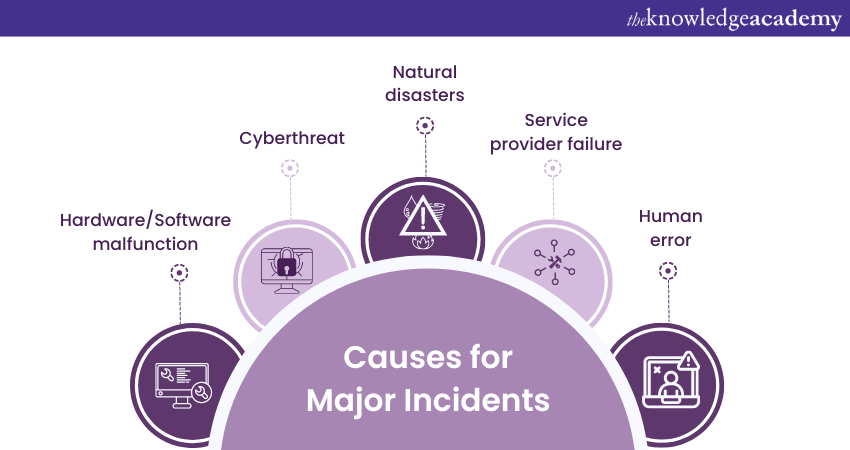
a) Hardware or software failure: Failure of equipment or software that performs functioning tasks can be significant and even lead category of operational health to a critical status.
b) Cyber Security failure: Cyberattacks, data breaches and other security incidents can cause significant damage to an organisation's IT infrastructure, which can result in major incidents.
c) Failure due to natural disasters: The forces of nature like earthquakes, hurricanes, or forests fires can heavily impact the IT network and degrade services of a business.
d) Service provider failure: Service providers that support an organisation's IT structure and overall infrastructure can experience outages or other issues, thereby leading to major incidents.
e) Failure due to human error: The IT professionals' mistakes as well as end users' errors can cause cyber crisis, including accidental distortion or configuring things wrongly.
ITIL Incident Management process
The process of Incident Management comprises seven pre-defined steps. The flow of these steps is as follows:
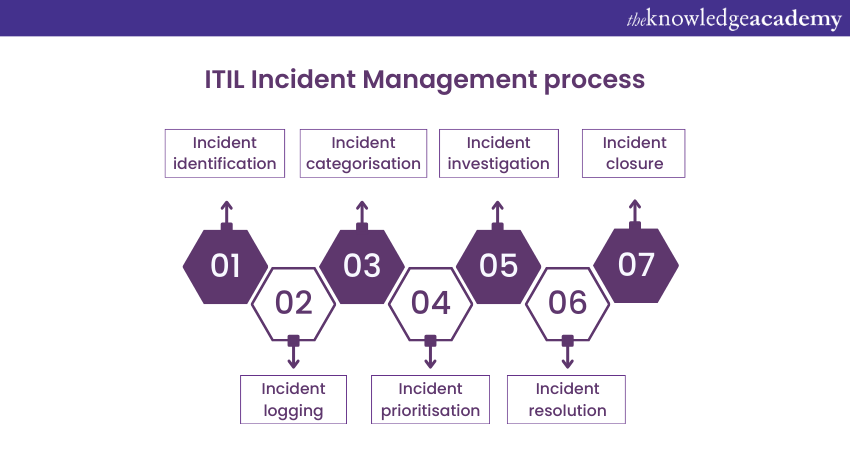
1) Incident identification
Identifying an incident is the first step in the ITIL Incident Management process. It involves recognising that an incident has occurred or is likely to occur based on various indicators such as user complaints, system alerts, or performance degradation.
Identification can be automated using monitoring tools or manually reported by users or IT staff performing routine checks. Proper incident identification is crucial as it enables IT teams to respond to these issues quickly, minimise service downtime, and restore services to normal operations as soon as possible.
2) Incident logging
Incident logging is a sub-process that begins when an incident is identified, and a ticket is created to log its details. The ticket contains vital information such as the date and time of occurrence, the person who reported it, and the severity of the impact on the organisation.
The ticket is then assigned to an IT support team member, who is responsible for resolving the issue. The support team member updates the ticket as they work on the incident, and once it is resolved, they close the ticket.
The incident logging process is critical in ensuring that all issues are managed effectively and that there is a clear record of them within the IT environment. This information can be used to identify trends, determine the root cause of recurring issues, and develop strategies to prevent issues in the future.
3) Incident categorisation
This stage is critical to the Incident Management flow. It involves classifying incidents based on their nature, impact and urgency. This step aims to ensure that all issues are dealt with effectively and efficiently by the appropriate support teams.
Impact refers to the extent to which the incident affects the business, while urgency refers to the time available to resolve the issue. Additionally, these issues are divided into categories based on nature, including hardware, software, network, security and others.
Each category has specific procedures and escalation paths that the support team needs to follow. Effective incident categorisation ensures that issues are resolved quickly, reducing downtime and minimising the impact on the business.
4) Incident prioritisation
Incident prioritisation is a framework that IT Service Management teams use to determine the urgency and importance of resolving issues. This process involves assigning a priority level to each incident based on its impact and urgency after the ticket has been registered and other external factors that may increase the complexity.
ITIL uses a priority matrix to help prioritise issues. The priority matrix is divided into four levels - Critical, High, Medium, and Low. The priority of an incident is determined by combining the urgency and impact ratings.
Issues with a high impact and high urgency are classified as critical, while those with a low priority and low urgency are classified as low. By prioritising incidents in this way, IT teams ensure that resources are allocated to those that have the most significant impact on the business and need the most urgent attention.
5) Incident investigation
Incident investigation is a process used by IT Service Management teams to identify the cause of an issue and restore services. Also referred to as incident diagnosis, it begins with the initial reporting, followed by a detailed analysis of the impact and urgency.
The first step in the incident investigation process is to gather information about the incident. This involves using several sources, such as end-users, system logs, and data-monitoring tools. The next step is to analyse the data to determine the issue's roots. After identifying the root cause, the IT Service Management team can work to resolve the issue and restore operations to normal.
Finally, the process involves documenting the incident and taking action to resolve the issue. This documentation can be used for future references and can also be used to improve the resolving process significantly.
By following a structured Incident investigation process, the IT Service Management team can improve service delivery, reduce downtime, and improve customer satisfaction.
6) Incident resolution
Incident resolution focuses on restoring normal service operation as quickly as possible after an issue arises. The process involves the Support Desk team or the individual who is responsible for issue resolution.
They are tasked with working closely with the stakeholders to ensure that the resolution meets their requirements and that the incident does not recur. Once the issue is resolved, the ticket should be closed, and the process should be reviewed to identify any areas of improvement.
7) Incident closure
The final stage of the ITIL Incident Management process is incident closure, where the issue is formally closed, and the report is updated. This stage is divided into the following steps:
a) The first step in the subprocess is verifying that the issue has been resolved. This involves checking that the symptoms reported by the user have been eliminated and that the underlying root cause of the issue has been identified and addressed.
b) Once the incident has been resolved, the record must be updated to reflect the resolution and any workarounds. The user is then notified that the incident has been resolved and that the ticket record has been closed.
c) The next step is to conduct a post-incident review, also known as a post-mortem or a root cause analysis. This review identifies the incident's root cause and any actions that can be performed to avoid the issue in the future.
d) The results of the post-mortem review are to be recorded in a separate report, which is used to inform future Incident Management processes operations, including considerations within ITIL Asset Management.
Benefits of implementing ITIL Incident Management
Understanding the advantages of ITIL Incident Management is crucial for maintaining a robust IT service environment. These benefits include the following:
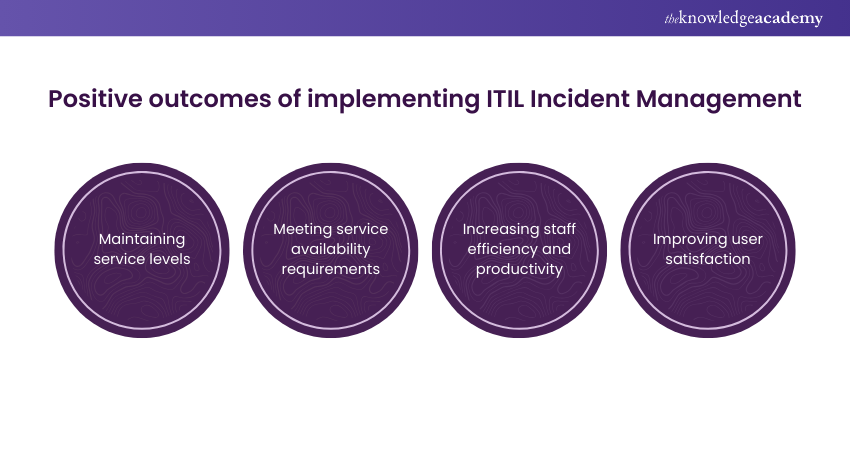
1) Maintaining service levels
By using ITIL Incident Management organisations keep the service levels consistent by quickly addressing and solving incidents which might provide the obstacles in regular business operations. Incident categories are defined by the set of processes established and incidents are organised according to their impact and urgency. This helps IT teams allocate resources and respond promptly. This approach ensures that even during the most challenging times, service disruptions are minimised, and the overall service quality adheres to the established standards.
2) Meeting service availability requirements
Downtime and disruptions can severely impact a business's reputation. ITIL Incident Management helps meet service availability requirements by placing focus on rapid Incident identification, analysis, and resolution.
By having a systematic process in place for incident escalation, tracking, and communication, businesses can cut their downtime down. They can also keep their services available for users, which ultimately helps improve their trust and loyalty.
3) Increasing staff efficiency and productivity
Implementing the ITIL Incident Management process streamlines workflows and offers clear guidelines to the IT staff. This structured approach cuts down ambiguity, ensuring that incidents are handled consistently and efficiently.
Incident documentation and knowledge repositories further empower staff with the information needed to resolve incidents without unnecessary delays. This, in turn, leads to enhanced staff productivity as more and more time is saved, and efforts are optimally directed towards the resolving of Incidents.
4) Improving user satisfaction
User satisfaction is important in modern business. ITIL Incident Management plays an essential role in improving user satisfaction by addressing any issues and reducing service disruptions. When Users Experience fewer disruptions, their perception of IT services becomes more positive. This experience promotes better relationships between IT and the rest of the organisation, improving overall collaboration and alignment.
Enlist now in our ITIL 4 Strategist - Direct, Plan, and Improve Course to master the skills to drive continuous improvement in your IT Service Management!
Example of Incident Management
An illustration of Incident Management is when a company’s server email gets a sudden disruption, and employees cannot send or receive email messages at the moment. The staff members of the Incident Management team may either be contacted through the organisation's service desk or monitoring system. They immediately look at the situation, decide how to rate it using two criteria: possible loss and urgency and then take steps to restore the service by carrying out necessary tasks.
Best Practice for Implementing Incident Management
Implementing Incident Management effectively requires adherence to best practices. Here are some key recommendations:
a) Identification: Recognising and logging incidents either through automated monitoring tools, user reports, or observations.
b) Logging: Recording details of the incident, including time of occurrence, affected systems or services, and initial assessment.
c) Categorisation: Classifying incidents based on predefined criteria such as impact, urgency, and priority levels.
d) Prioritisation: Determining the order in which incidents will be addressed based on their impact on business operations and urgency.
e) Investigation and diagnosis: Investigating the root cause of the incident to understand why it occurred and diagnose the underlying problem.
f) Resolution: Implementing appropriate measures to resolve the incident and restore normal service operation as quickly as possible.
g) Escalation: Escalating incidents to higher levels of support or management for additional resources or expertise.
h) Communication: Keeping stakeholders informed about the incident's status, progress, and expected resolution time.
i) Resolution and recovery: Implementing fixes, workarounds, or mitigations to resolve the incident and restore service functionality.
j) Closure: Formally closing the incident record after verifying that the issue has been resolved and normal service operation has been restored.
Incident Management tools
Here are some of the most common categories of tools that can be used for effective Incident Management:
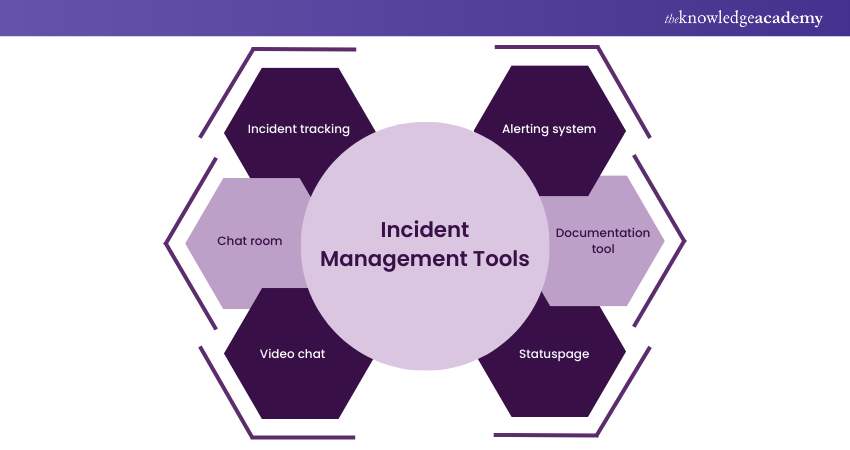
a) Incident tracking: It is an important tool to track and document every incident so that you can identify trends and make comparisons over time.
b) Chat room: Chatroom proves real-time text communication. This is the key for diagnosing and resolving the incident as a team. It also provides a rich set of data for response analysis later on.
c) Video chat: Video chat complements text chat for many incidents, and team video chat can help discuss the findings and map out a response strategy.
d) Alerting system: A tool such as Jira Service Management integrates with your monitoring system and manages on-call rotations and escalations.
e) Documentation tool: A tool such as Confluence can capture incident state documents and postmortems.
f) Statuspage: Communicating status with both internal stakeholders and customers through Statuspage helps keep everyone in the loop.
Learn about various guiding principles of ITIL in Digital and IT strategy with our ITIL® 4 Leader: Digital And IT Strategy Certification now!
Roles in Incident Management
ITIL Incident Management is a crucial process in IT Service Management that ensures the rapid restoration of normal service operations and minimises the impact of incidents on business operations.
Within this process several professionals invest their efforts in providing incident resolution. Each role plays a vital part in the seamless operation of this process. Here's an overview of the key roles in ITIL Incident Management:
1) Incident Manager
The Incident Manager is accountable for managing and coordinating the Incident Management procedure. This task involves, among other things, putting together the response efforts and making sure that incidents are properly categorised, prioritised, and communicated effectively. The Incident Manager collaborates with several teams to allocate resources, track progress, and communicate Incident updates to stakeholders.
2) Incident Analyst/Coordinator
The Incident Analyst or Coordinator plays an essential role in the incident response process. They are involved in the following:
Receiving and acknowledging incident reports
Performing any necessary initial assessments
Ensuring Incidents are appropriately documented and escalated depending on their impact and urgency.
3) Technical support teams
Technical support teams consist of specialists who possess the necessary technical expertise to identify and address incidents. These teams are held responsible for investigating, troubleshooting, and applying fixes to restore the affected services. Here are some of their responsibilities:
1) Responding to incident assignments promptly and acknowledging receipt
2) Conducting thorough investigations to identify the root cause of Incidents
3) Collaborating with other teams and stakeholders to implement temporary workarounds or permanent solutions
4) Updating incident records with relevant information and progress
5) Escalating incidents to higher-level support or management if necessary
4) Communication Liaison
Effective communication during incidents is crucial to keep the stakeholders informed and manage expectations properly. The Communication Liaison makes sure that accurate and timely information is shared with relevant parties, both internal and external. Here are some of their responsibilities:
1) Providing regular updates to users, customers, and stakeholders about Incident status
2) Creating and maintaining communication channels to disseminate Incident-related information
3) Crafting clear and concise Incident communication messages
4) Making sure that communication aligns with the organisation's policies and guidelines
5) Managing user expectations regarding Incident resolution timelines
Learn how to add value to digital products – start with signing up for ITIL® 4 Specialist: High Velocity IT Training now!
Conclusion
This blog has elaborately addressed the ITIL Incident Management, which consists of steps and structure. The importance of Incident Management should not be underestimated because it helps companies maximise performance by minimising the negative effects of disruptions on business operations. By following the framework, organisations can effectively manage incidents.
Transform your IT Service Management skills with our comprehensive ITIL Certification Courses and advance your career today!
Frequently Asked Questions

The key to success in Incident Management lies in preparation, communication, and swift action. Establishing clear protocols, fostering effective teamwork, and maintaining transparency are crucial. Timely assessment, decisive responses, and continuous improvement ensure resilience in handling unexpected events safeguarding operations and reputation.<

ITIL Incident Management focuses on restoring the service to its normal state quickly and efficiently. Thus, organisations can improve customer satisfaction, perception, and loyalty. It can lessen the negative impact of incidents on the business outcomes and productivity of the customers.

The Knowledge Academy takes global learning to new heights, offering over 30,000 online courses across 490+ locations in 220 countries. This expansive reach ensures accessibility and convenience for learners worldwide.
Alongside our diverse Online Course Catalogue, encompassing 17 major categories, we go the extra mile by providing a plethora of free educational Online Resources like News updates, Blogs, videos, webinars, and interview questions. Tailoring learning experiences further, professionals can maximise value with customisable Course Bundles of TKA.

The Knowledge Academy’s Knowledge Pass, a prepaid voucher, adds another layer of flexibility, allowing course bookings over a 12-month period. Join us on a journey where education knows no bounds.

Discover an array of ITIL Certification Courses at The Knowledge Academy, featuring specialised training in ITIL 4 Foundation, Support CDS, and High velocity IT Training. Designed for different skill levels, our courses provide the necessary technical expertise to meet ISO 20000 vs ITIL.
Whether you're starting out or looking to upgrade your skills, immerse yourself in our IT Service Management Blogs for further understanding and expertise. Embark on a journey with us to elevate your ITIL Certification proficiency!
Upcoming IT Service Management Resources Batches & Dates
Date
 ITIL® 4 Foundation Certification Course
ITIL® 4 Foundation Certification Course
Mon 29th Jul 2024
Wed 31st Jul 2024
Mon 5th Aug 2024
Wed 7th Aug 2024
Sat 10th Aug 2024
Mon 12th Aug 2024
Wed 14th Aug 2024
Mon 19th Aug 2024
Wed 21st Aug 2024
Sat 24th Aug 2024
Tue 27th Aug 2024
Thu 29th Aug 2024
Mon 2nd Sep 2024
Wed 4th Sep 2024
Sat 7th Sep 2024
Mon 9th Sep 2024
Wed 11th Sep 2024
Mon 16th Sep 2024
Wed 18th Sep 2024
Sat 21st Sep 2024
Mon 23rd Sep 2024
Wed 25th Sep 2024
Mon 30th Sep 2024
Wed 2nd Oct 2024
Sat 5th Oct 2024
Mon 7th Oct 2024
Wed 9th Oct 2024
Mon 14th Oct 2024
Wed 16th Oct 2024
Sat 19th Oct 2024
Mon 21st Oct 2024
Wed 23rd Oct 2024
Mon 28th Oct 2024
Wed 30th Oct 2024
Sat 2nd Nov 2024
Mon 4th Nov 2024
Wed 6th Nov 2024
Mon 11th Nov 2024
Wed 13th Nov 2024
Sat 16th Nov 2024
Mon 18th Nov 2024
Wed 20th Nov 2024
Mon 25th Nov 2024
Wed 27th Nov 2024
Sat 30th Nov 2024
Mon 2nd Dec 2024
Wed 4th Dec 2024
Mon 9th Dec 2024
Wed 11th Dec 2024
Sat 14th Dec 2024
Mon 16th Dec 2024
Wed 18th Dec 2024
Mon 6th Jan 2025
Wed 8th Jan 2025
Mon 13th Jan 2025
Wed 15th Jan 2025
Mon 20th Jan 2025
Wed 22nd Jan 2025
Mon 27th Jan 2025
Wed 29th Jan 2025
Mon 3rd Feb 2025
Wed 5th Feb 2025
Mon 10th Feb 2025
Wed 12th Feb 2025
Mon 17th Feb 2025
Wed 19th Feb 2025
Mon 24th Feb 2025
Wed 26th Feb 2025
Mon 3rd Mar 2025
Wed 5th Mar 2025
Mon 10th Mar 2025
Wed 12th Mar 2025
Mon 17th Mar 2025
Wed 19th Mar 2025
Mon 24th Mar 2025
Wed 26th Mar 2025
Mon 31st Mar 2025
Wed 2nd Apr 2025
Mon 7th Apr 2025
Wed 9th Apr 2025
Mon 14th Apr 2025
Wed 16th Apr 2025
Tue 22nd Apr 2025
Mon 28th Apr 2025
Wed 30th Apr 2025
Tue 6th May 2025
Mon 12th May 2025
Wed 14th May 2025
Mon 19th May 2025
Wed 21st May 2025
Tue 27th May 2025
Mon 2nd Jun 2025
Wed 4th Jun 2025
Mon 9th Jun 2025
Wed 11th Jun 2025
Mon 16th Jun 2025
Wed 18th Jun 2025
Mon 23rd Jun 2025
Wed 25th Jun 2025
Mon 30th Jun 2025
Wed 2nd Jul 2025
Mon 7th Jul 2025
Wed 9th Jul 2025
Mon 14th Jul 2025
Wed 16th Jul 2025
Mon 21st Jul 2025
Wed 23rd Jul 2025
Mon 28th Jul 2025
Wed 30th Jul 2025
Mon 4th Aug 2025
Wed 6th Aug 2025
Mon 11th Aug 2025
Wed 13th Aug 2025
Mon 18th Aug 2025
Wed 20th Aug 2025
Mon 25th Aug 2025
Mon 1st Sep 2025
Wed 3rd Sep 2025
Mon 8th Sep 2025
Wed 10th Sep 2025
Mon 15th Sep 2025
Wed 17th Sep 2025
Mon 22nd Sep 2025
Wed 24th Sep 2025
Mon 29th Sep 2025
Wed 1st Oct 2025
Mon 6th Oct 2025
Wed 8th Oct 2025
Mon 13th Oct 2025
Wed 15th Oct 2025
Mon 20th Oct 2025
Wed 22nd Oct 2025
Mon 27th Oct 2025
Wed 29th Oct 2025
Mon 3rd Nov 2025
Wed 5th Nov 2025
Mon 10th Nov 2025
Wed 12th Nov 2025
Mon 17th Nov 2025
Wed 19th Nov 2025
Mon 24th Nov 2025
Wed 26th Nov 2025
Mon 1st Dec 2025
Wed 3rd Dec 2025
Mon 8th Dec 2025
Wed 10th Dec 2025
Mon 15th Dec 2025
Wed 17th Dec 2025







 Top Rated Course
Top Rated Course



 If you wish to make any changes to your course, please
If you wish to make any changes to your course, please


